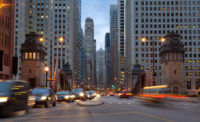The lawsuit, filed in federal court in Chicago, alleges that the renovation and expansion project discriminated against people with disabilities.
If found guilty, the Cubs could be forced to make costly changes to the stadium as well as pay damages.
While the work "enhanced the game day experience for many fans, particularly those able to take advantage of premium clubs and other luxury accommodations, the same cannot be said for fans with disabilities,” the 29-page complaint states.
The Cubs had 'ample opportunity' and an obligation under the law 'to incorporate wheelchair seating and other accessible elements into the updated facility.'
U.S. Attorney John Lausch
The Cubs had "ample opportunity" and an obligation under the law "to incorporate wheelchair seating and other accessible elements into the updated facility,” U.S. Attorney John Lausch said in a statement.
In their defense, the Cubs issued a statement saying that they are disappointed by the lawsuit and hope for an amicable resolution. The team also said it actually improved access for the disabled in many ways.
Wrigley Field, the second-oldest major league ballpark, was added as a National Historic Landmark in September 2020 after the renovation was completed. Major League Baseball and the Cubs owners had opposed seeking the designation before the big renovation because the team believed it would limit its ability to modernize and make the park more accessible.
Another Chicago pro sports venue, Soldier Field, lost its National Historic Landmark designation in 2006 after the 2002 renovation of the stadium and war memorial was judged by the National Parks Service to have too radically altered the structure.
The Wrigley field lawsuit claims the Cubs removed the best wheelchair seating and failed to incorporate it in new premium clubs and group seating areas. Wheelchair seating in the last row of general admission areas does not meet ADA standards, the lawsuit says. Architectural barriers, the U.S. attorney charges, were left in place in unaltered portions of the stadium.
Design Firms, Contractor Not Liable
None of the design firms involved in the renovation, known as the 1060 Project for Wrigley Field's address at 1060 W. Addison St. on Chicago's north side, are named in the lawsuit. That made it seem like the U.S. attorney believed accessible design decisions were made only by the Cubs' majority owners, the Ricketts family. The two main design firms, Populous and Stantec, could still have their employees called as potential witnesses to explain design decisions should the lawsuit proceed to depositions or, eventually, a trial.
The project's main contractor, Pepper Construction Co., is also not named in the lawsuit.
The project entailed demolishing and reconstructing the bleachers and tearing down and rebuilding most of the lower grandstand. For the work, ENR named it ENR Midwest Best Project in 2019, with judges noting the significant unknown condition of the foundations and quality of soil underneath the original 1914 structure.
Extensive Criticism of Stadium Changes
Wrigley Field, in one example cited in the lawsuit, previously had "15 general admissions wheelchair seats with excellent, unobstructed views over standing spectators on the main bleacher concourse in the right field."
The U.S. Attorney alleges that the Cubs made a decision to eliminate those wheelchair seats by converting the space into a patio, which is accessible to wheelchair users, but only if they are part of a group that has rented the space at a cost that is typically more expensive per person than general admission seating.
The lawsuit also alleges a range of other deficiencies including inaccessible routes from the main concourse to the club, paper towel dispensers mounted out of reach range in bathrooms, sales and service counters that exceed the maximum height of 36 inches above the finish floor, and many protruding objects, such as drinking fountains and TVs, that are 27 inches above the finish floor and extend into circulation paths.The team maintains that “the renovation of Wrigley Field greatly increased accessibility of the ballpark and was completed in accordance with applicable law and historic preservation standards consistent with the ballpark’s designation as a National and City of Chicago landmark.”
The Cubs also contend that the field “is now more accessible than ever in its 108-year history, demonstrated by increasing accessible seating options by more than 50% on and across more levels and in more locations.”
Among the improvements cited by the team are 11 more elevators, more accessible restroom facilities, assistive listening technology for fans with hearing impairments, enhanced audio speakers and sound systems throughout the ballpark.




.jpg?height=200&t=1665514235&width=200)

Post a comment to this article
Report Abusive Comment